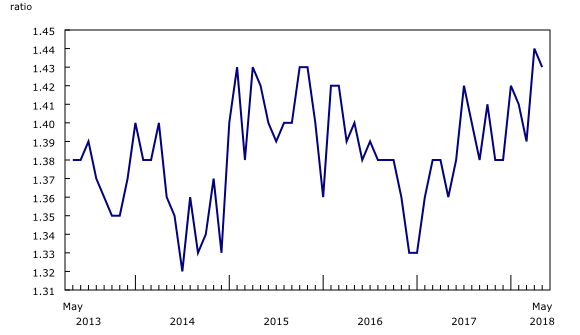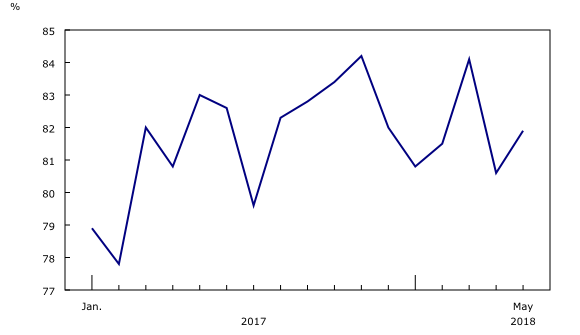Monthly Survey of Manufacturing, May 2018
Archived Content
Information identified as archived is provided for reference, research or recordkeeping purposes. It is not subject to the Government of Canada Web Standards and has not been altered or updated since it was archived. Please "contact us" to request a format other than those available.
Released: 2018-07-17
Manufacturing sales increased 1.4% to $57.1 billion in May, following a 1.1% decline in April.
Sales rose in 14 of 21 industries, representing 64% of total manufacturing sales. The chemical, machinery, and wood product industries accounted for most of the gains in May. The transportation equipment industry posted the largest decline.
In constant dollars, manufacturing sales were up 0.9%.
Higher sales of chemical and machinery products drive manufacturing growth
Sales in the chemical industry were up for the second consecutive month, rising 6.2% to $4.7 billion in May on higher volumes of products sold. There were widespread gains in most chemical sub-industries, particularly in the pesticide, fertilizer and other agricultural chemical manufacturing industry.
Machinery sales rose 8.9% to $3.3 billion, following three consecutive monthly declines. Higher sales of other general-purpose machinery as well as commercial and service machinery led the gains.
Sales in the transportation equipment industry declined 1.9% to $10.6 billion, following a 2.4% decrease in April. The declines in May were primarily due to lower sales of motor vehicles and motor vehicles parts. In particular, motor vehicle sales were down 6.6%, while sales of motor vehicles parts decreased 3.7%. Higher production of aerospace products and parts (+7.4%) partially offset the overall sales decline in transportation equipment.
The petroleum and coal product industry declined for the fourth consecutive month, with sales down 1.8% to $5.2 billion in May. Despite higher prices for energy and petroleum products, extended shutdowns at several refineries for maintenance and retooling work in Eastern Canada led to the decline. Volumes of products sold were down 4.7% as a result of the shutdowns.
Sales increase in seven provinces
Manufacturing sales were up in seven provinces in May, led by Alberta and British Columbia.
Sales in Alberta rose 7.9% to $6.3 billion, with increases in 15 of 21 industries. Sales of petroleum and coal products (+25.2%) led the gains, following multiple shutdowns at refineries for maintenance work in April. Excluding the petroleum and coal products industry, sales in Alberta rose 3.7%.
Manufacturing sales in British Columbia were up for the third consecutive month, rising 3.2% in May. Wood product manufacturing (+9.2%) was the main contributor to the gain.
Sales in Quebec rose 1.0% to $13.5 billion, following a 3.3% decline in April. The increase reflected gains in the aerospace product and parts industry (+14.2%). Sales were also up in the machinery and paper industries. Lower sales in the petroleum and coal products industry offset some of the gains.
In Manitoba, sales rose 7.5% to $1.8 billion. The gain reflected higher sales in 11 of 21 industries.
Newfoundland and Labrador (-29.7%) posted the largest decline in May on lower sales of non-durable goods.
Higher inventory levels
Manufacturing inventories rose 0.4% to a record high $81.5 billion in May. Inventories were up in 9 of 21 industries, representing 58% of total manufacturing inventories. The increase was driven by the machinery industry (+4.1%) followed by transportation equipment (+1.7%). The gains were moderated by a 5.3% decline in petroleum and coal products.
The inventory-to-sales ratio decreased from 1.44 in April to 1.43 in May. The inventory-to-sales ratio measures the time, in months, that would be required to exhaust inventories if sales were to remain at their current level.
Unfilled orders increase
Unfilled orders were up 3.5% to $92.8 billion in May, the fourth consecutive monthly gain. Higher levels of unfilled orders in the aerospace product and parts industry were mainly responsible for the overall rise in unfilled orders in May.
New orders were also up in May, increasing 4.9% to $60.2 billion. The gain was largely due to the aerospace product and parts industry. The overall increase was partially offset by a 13.3% decline in new orders for fabricated metal products.
Capacity utilization rates
The unadjusted manufacturing capacity utilization rate increased from 80.6% in April to 81.9% in May. In the machinery industry, the capacity utilization rate rose from 70.3% to 75.9%. This gain was consistent with higher production and sales in the industry. The rate also rose substantially in the fabricated metal products industry.
The petroleum and coal product industry reported a large decline in capacity utilization. The unadjusted rate decreased from 73.5% to 64.9% in May, reflecting the extended shutdowns at several refineries.
Note to readers
Monthly data in this release are seasonally adjusted and are expressed in current dollars unless otherwise specified.
For information on seasonal adjustment, see Seasonally adjusted data – Frequently asked questions. For information on trend-cycle data, see Trend-cycle estimates – Frequently asked questions.
Non-durable goods industries include food, beverage and tobacco products, textile mills, textile product mills, clothing, leather and allied products, paper, printing and related support activities, petroleum and coal products, chemicals, and plastics and rubber products.
Durable goods industries include wood products, non-metallic mineral products, primary metals, fabricated metal products, machinery, computer and electronic products, electrical equipment, appliances and components, transportation equipment, furniture and related products, and miscellaneous manufacturing.
Production-based industries
For the aerospace and shipbuilding industries, the value of production is used instead of the value of sales of goods manufactured. The value of production is calculated by adjusting monthly sales of goods manufactured by the monthly change in inventories of goods in process and finished products manufactured. The value of production is used because of the extended period of time that it normally takes to manufacture products in these industries.
Unfilled orders are a stock of orders that will contribute to future sales assuming that the orders are not cancelled.
New orders are those received, whether sold in the current month or not. New orders are measured as the sum of sales for the current month plus the change in unfilled orders from the previous month to the current month.
Manufacturers reporting in US dollars
Some Canadian manufacturers report sales, inventories and unfilled orders in US dollars. These data are then converted to Canadian dollars as part of the data production cycle.
For sales, based on the assumption that they occur throughout the month, the average monthly exchange rate for the reference month (noon spot rate) established by the Bank of Canada is used for the conversion. The monthly average exchange rate is available in table 33-10-0163-01. Inventories and unfilled orders are reported at the end of the reference period. For most respondents, the noon spot exchange rate on the last working day of the month is used for the conversion of these variables.
However, some manufacturers choose to report their data as of a day other than the last day of the month. In these instances, the noon spot exchange rate on the day selected by the respondent is used. Note that because of exchange rate fluctuations, the noon spot exchange rate on the day selected by the respondent can differ from both the exchange rate on the last working day of the month and the monthly average exchange rate. Noon spot exchange rate data are available in table 33-10-0036-01.
Capacity utilization rates
With this release, the Monthly Survey of Manufacturing has begun publishing monthly data on capacity utilization rates for the manufacturing sector and the main manufacturing industries. The data are not seasonally adjusted and have been compiled back to the January 2017 reference month.
Monthly data on capacity utilization rates will be integrated into the quarterly industrial capacity utilization rates program at a future point.
Revision policy
Each month, the Monthly Survey of Manufacturing releases preliminary data for the reference month and revised data for the three previous months. Revisions are made to reflect new information provided by respondents and updates to administrative data.
Real-time data tables
Real-time data tables 16-10-0118-01, 16-10-0119-01 and 16-10-0014-01 will be updated on July 30.
Next release
Data from the Monthly Survey of Manufacturing for June will be released on August 16.
Contact information
For more information, contact us (toll-free 1-800-263-1136; 514-283-8300; STATCAN.infostats-infostats.STATCAN@canada.ca).
To enquire about the concepts, methods or data quality of this release, contact Michael Schimpf (613-863-4480; michael.schimpf@canada.ca), Manufacturing and Wholesale Trade Division.
- Date modified:








